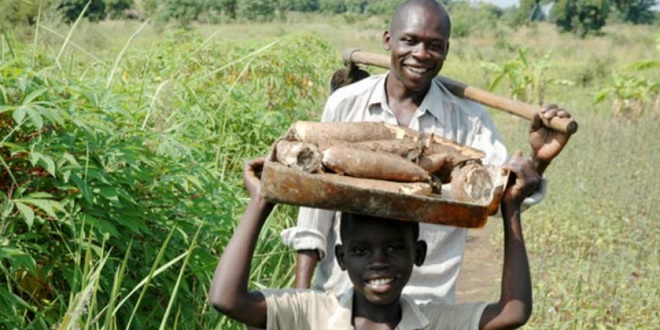
Extreme poverty in Uganda fell from 53.2% in 2006 to 34.6% in 2013
Poverty reduction among households in agriculture accounts for 79 percent of of national poverty decline from 2006 to 2013.
According to the World Bank Group’s latest Poverty Assessment, the proportion of the Ugandan population living beneath the national poverty line declined from 31.1 percent in 2006 to 19.7 percent in 2013. Uganda was also one of the fastest in Sub-Saharan Africa to reduce the share of its population living on $1.90 PPP per day or less, from 53.2 percent in 2006 to 34.6 percent in 2013.
The growth in agricultural incomes of households over this decade was driven by favorable food prices and good rainfall, enabling poor smallholder farmers to obtain higher incomes from their produce. The government’s increased spending on road infrastructure, education, growth in urban centers, promotion of trade and access to new regional markets, as well as the return of peace to the war-torn northern region contributed significantly to further poverty reduction.
Despite these gains, the country’s performance on some important non-monetary dimensions of well-being is low. Access to basic services such as electricity and sanitation facilities remains limited, educational completion and progression remain low, and one in three Ugandan children are stunted, pointing to persistent malnutrition. Lack of progress in these areas poses a formidable barrier to the country’s aspiration of becoming a low middle income country by 2020. It must be noted however, that Uganda has made significant progress in other human development outcomes, such as child and infant mortality, maternal mortality and access to improved water, in the last decade.
A significant increase in agricultural income, in addition to good rainfall, favorable prices, and political stability, have contributed to this reduction in poverty.
Regional inequality persists and appears to be on the rise. Progress was slower in the country’s north and eastern regions which have the least well-off, and marginalized population. The proportion of the total number of poor people who live in the Northern and Eastern regions increased between 2006 and 2013, from 68 percent to 84 percent, according to the report. Poverty incidence is also higher in the north (43.7 percent) and the east (24.5 percent) compared to the central (4.7 percent) and the west (8.7 percent).
A third of Ugandans remain poor and vulnerable to shocks despite the reduction of poverty. Between 2005 and 2009, for every three Ugandans who were lifted out of poverty, two fell back in. In addition, high fertility rates have held back poverty reduction in the country, by increasing the dependency ratio and slowing consumption growth among poor households by 15 to 20 percent, and have limited the participation of women in the economic development of the country.
Despite this progress, efforts to improve non-monetary dimensions of poverty such as access to adequate sanitation and electricity, are needed to improve the standard of living for Uganda’s poorest.
“Most Ugandans are either poor or vulnerable to poverty. For every three families who escape poverty, two fall back in,” said Christina Malmberg Calvo, World Bank Country Manager for Uganda. “Bridging the regional divide is critical by spurring agricultural growth and improving education, health and basic infrastructure services.”
The long-term development vision of Uganda is to transform from a predominantly peasant and low income country to a competitive low middle income one by the year 2020. Reducing the number of people living in poverty will require both modernizing agricultural production and expanding employment income in non-agricultural sectors, according to the report. Lower fertility could also contribute significantly to further poverty reduction. The report emphasizes the continued transformative role of agriculture and proposes policy measures that focus on making better quality inputs and extension services available to farmers, alongside affordable credit.
FULL REPORT
World Bank Uganda Poverty Assessment Report 2016 by The Independent Magazine on Scribd
 The Independent Uganda: You get the Truth we Pay the Price
The Independent Uganda: You get the Truth we Pay the Price


